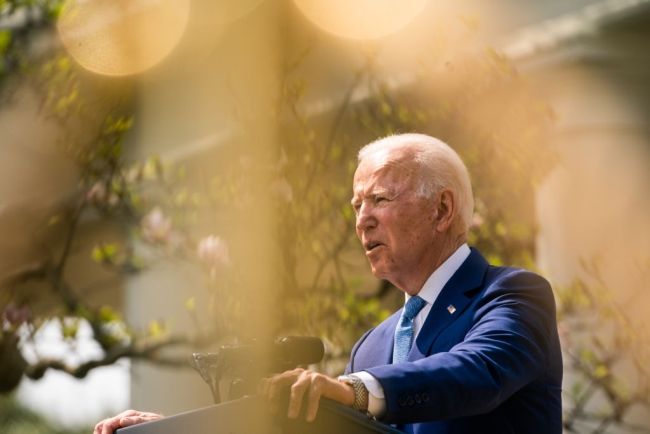You have /5 articles left.
Sign up for a free account or log in.

President Biden
Demetrius Freeman/The Washington Post/Getty Images
On Friday, President Biden released his request to the Senate for fiscal year 2022 discretionary funding, also known as the “skinny budget,” because details will follow. The document requests several funding increases for higher education. If enacted, the plan would:
- Increase Pell Grants: An additional $3 billion would go toward funding federal Pell Grants, increasing the maximum award by $400 -- the largest one-time increase in more than a decade. (The current maximum is $6,495.) So-called Dreamers, immigrants brought by their parents to the United States without permission as children, would also be eligible for the grants. President Biden says the funding is part of a larger effort to double the maximum Pell award.
- Increase Education Department funding: The plan increases funding to the Education Department by nearly $30 billion, or 41 percent of the previous year’s budget level. Total funding would be $102.8 billion.
- Increase funding for the NSF: The request includes $10.2 billion for the National Science Foundation, a $1.7 billion or 20 percent increase from the 2021 funding level.
- Support for minority-serving institutions: The plan calls for an additional $600 million for historically Black colleges and universities, tribal colleges and universities, and other minority-serving institutions, as well as “low-resourced institutions,” including community colleges.
- Upgrade STEM paths at minority-serving institutions: The request increases research funding opportunities at HBCUs and minority-serving institutions, while also investing in their lab and IT infrastructure. The plan would additionally fund workforce development programs in STEM at those institutions.
- Fund women's programs at minority-serving institutions: The plan gives $1 billion to the Department of Justice for Violence Against Women Act programs, including funding to support women at HBCUs, Hispanic-serving institutions and tribal colleges, “to ensure these institutions have the same resources as other schools to address this pervasive issue.”
- Fund renewables at tribal colleges: The plan calls for $450 million to facilitate climate mitigation and resilience projects in Indian country, including “investment to begin the process of transitioning tribal colleges to renewable energy.”
- Attract minority students to STEM: The request provides a $20 million increase for the Office of STEM Engagement to “expand initiatives to attract and retain underserved and underrepresented students in engineering and other STEM fields, in partnership with minority serving institutions and other higher education institutions.” The increase would be 16 percent of the current enacted budget for those initiatives.
The plan requires congressional approval, and congressional Republicans will likely object to some of the president's chosen investments.
Higher education experts applauded the planned investments, while also highlighting areas the White House could fund further. While the growth of the Pell program was seen as a great step by many, it stands in the shadow of the proposals to double the maximum Pell award, which is closer to what many organizations believe is needed. President Biden did say his funding increase would be a step toward doubling the award in the future.
Terry Hartle, senior vice president for government relations at the American Council on Education, said the budget was strong but not remarkable for higher ed. The investments in the Pell program and HBCUs, he said, were certainly welcome, but doubling the value of Pell Grants is still needed.
“It’s good news for education; it’s good news for college students. It’s not as great as we might have wished, but it’s a huge step forward,” he said. “I think what we’re seeing here is campaign rhetoric has met with governing reality. They can’t do everything that they want as quickly as they want.”
Doubling the value of Pell Grants would cost $35 billion per year, Hartle said, and it’s likely that the president couldn’t ask Congress for that amount while also requesting $20 million for Title I funding -- another line in the budget that would go to K-12 schools with a high percentage of low-income children. The Biden administration has said it still plans on an effort to double the value of Pell Grants, and Hartle said the White House may seek to do so through a different route, such as making Pell an entitlement through another COVID-19 recovery package.
Deborah Santiago, CEO of Excelencia in Education, said the plan sends a strong message about the approach the administration wants to take to higher education. She appreciated funding for capacity and infrastructure at Hispanic-serving institutions, which are the most numerous minority-serving institutions, as well as the increase in funding for the Pell program. Greater funding for institutional workforce training is one thing she would have liked to see more of.
“It sends a really strong message about the tone and approach this administration wants to take in a higher education focus,” she said. Santiago also said she appreciated the framing the budget document took toward equity, which centered around a “drive” toward equity, not claiming one document would solve all problems.
David Baime, senior vice president for government relations at American Association of Community Colleges, said the association is particularly pleased with the increase in funding for the Pell program and for MSIs, as well as the additional support for apprenticeships.
“It represents a phenomenal and long-overdue investment in education,” he said. “It builds on the American Jobs Plan Act, which recognizes the values and needs of community college students and institutions.”
Community colleges are still eager to advance the America’s College Promise Act -- legislation that would waive tuition at two-year institutions for eligible students, Baime said, and they anticipate the White House will advance that or similar proposals in coming weeks.
The Institute for Higher Education Policy said that the investments, especially in Pell and MSIs, were more than welcome, but also said that doubling the value of the Pell Grants will be critical, along with indexing the value of the awards to inflation.
“Unfortunately, funding for the [Pell] program has failed to keep pace with rising college costs. While the award once covered more than half the costs at a public four-year college, it now covers less than one-third,” the organization said in a statement. “While we welcome these topline investments, we also hope to see increased investments in other postsecondary programs, including campus-based aid programs and important data systems and collections, including the Institute of Education Sciences (IES) and the State Longitudinal Data Systems (SLDS) grant program.”
The Institute for College Access & Success said the budget plan is “an encouraging step toward making college more affordable” and closing equity gaps in education. Increasing Pell funding and expanding eligibility to Dreamers are good decisions, but doubling the value of Pell is still needed, the organization said.
“Overall, today's proposal is an opening bid that recognizes the need for significant federal investment to make higher education more affordable and equitable,” TICAS wrote in a statement.
The Association of Public and Land-grant Universities highlighted, in addition to Pell funding, the budget’s increases to research and development.
“The request’s proposed historic increases in federal research agencies such as the National Science Foundation, the National Aeronautics and Space Administration, the Department of Energy, the National Institutes of Health, and the United States Department of Agriculture would turbocharge discovery and innovation,” the association said in a statement. “Federal research investment is the lifeblood of American innovation and the administration’s proposal would ensure the U.S. is positioned to lead in critical areas such as health, climate, and manufacturing.”
The Association of American Medical Colleges highlighted the budget’s investments in health and medical research, specifically $51 billion for the National Institutes of Health and increases for the Department of Health and Human Services and Centers for Disease Control and Prevention.
“As we await submission of the president’s full FY 2022 budget request, we strongly encourage the administration to prioritize another critical investment in the nation’s health care infrastructure through the expansion of federally-supported graduate medical education positions that would help to alleviate our physician shortage and improve access to high-quality care,” the organization wrote in a statement.
The White House will likely release a completed budget, going into greater detail about investments, later this spring.








